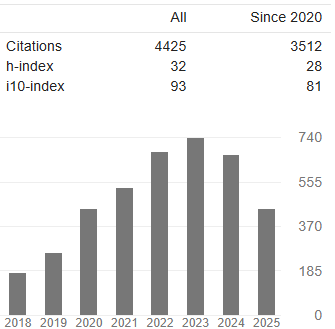THE ASSOCIATION BETWEEN INDIVIDUAL, PHYSICAL, AND PSYCHOSOCIAL RISK FACTORS AND OCCUPATIONAL FATIGUE AMONG COMMUTER LINE TRAIN WORKERS

Introduction: Occupational fatigue affects workers in various industries including transportation. Commuter train drivers and office workers are subjected to high levels of physical and psychosocial stress, which can lead to occupational fatigue. Aims: to examine the relationship between individual, physical, and psychosocial risk factors and occupational fatigue in commuter train workers in Jakarta, Bogor, Tangerang, and Bekasi. Methods: Individual (i.e., age, gender, marital status, type of work, duration of work, and smoking status), psychosocial (i.e., effort, reward, overcommitment, monotonous work, social support, job satisfaction, and work stress) factors, and occupational fatigue were investigated in 78 commuter line train workers (both drivers and officers). Observing workers' activities yielded physical factors (awkward posture, repetitive work, prolonged work, and material manual handling activities). The association between each risk factor and occupational fatigue was investigated using a logistic regression model. Results: Commuter line officers (OR 4.96, 95% CI 1.77 – 13.85), those with high overcommitment (OR 3.16, 95% CI 1.25 – 8.00), and those with high work stress (OR 1.54, 95% CI 1.19 – 2.00) were more likely to report occupational fatigue than train drivers, who reported low overcommitment and low work stress, respectively. When compared to those who reported low job satisfaction, those who reported high job satisfaction were less likely to report occupational fatigue (OR 0.19, 95% CI 0.07 – 0.52). Conclusion: Job position, overcommitment, and work stress were associated with occupational fatigue.
Baeriswyl, S., Krause, A. and Schwaninger, A. 2016. Emotional exhaustion and job satisfaction in airport security officers–work–family conflict as mediator in the job demands–resources model. Frontiers in psychology 7 663
Bazazan, A. et al. 2014. Demographic factors and their relation to fatigue and mental disorders in 12-hour petrochemical shift workers. Health promotion perspectives 4(2) 165
Choobineh, A. et al. 2018. The prevalence of fatigue, sleepiness, and sleep disorders among petrochemical employees in Iran. Fatigue: Biomedicine, Health & Behavior 6(3) 153-162.
David, G., Woods, V., Li, G.Y. and Buckle, P. 2008. The development of the Quick Exposure Check (QEC) for assessing exposure to risk factors for work-related musculoskeletal disorders. Applied Ergonomics 39(1) 57-69 https://doi.org/10.1016/j.apergo.2007.1003.1002.
Directorate General of Railways Ministry of Transportation. 2020. Statistik korban kecelakaan pertahun, 2015-2019 [online]: Direktorat Jenderal Perkerataapian Kementrian Perhubungan 2021].
Harma, M. et al. 2002. The effect of an irregular shift system on sleepiness at work in train drivers and railway traffic controllers. Journal of Sleep Research 11(2) 141-151 https://doi.org/110.1046/j.1365-2869.2002.00294.x.
Health and Safety Executive UK 2006. Managing Shiftwork: Health and Safety Guidance. Suffolk, HSE Books.
Huynh, J.Y., Xanthopoulou, D. and Winefield, A.H. 2013. Social support moderates the impact of demands on burnout and organizational connectedness: A two-wave study of volunteer firefighters. Journal of Occupational Health Psychology 18(1) 9 https://doi.org/10.1037/a0030804.
Jacobs, B.W., Kawatu, P. and Maramis, F. 2015. Hubungan antara Stres Kerja dengan Kelelahan Kerja pada Karyawan Bagian Sumber Daya Manusia di PT. Bank Sulut Cabang Manado. Jurnal Administrasi Publik 4(32).
Karasek, R. et al. 2007. Testing two methods to create comparable scale scores between the Job Content Questionnaire (JCQ) and JCQ-like questionnaires in the European JACE Study. International Journal of Behavioral Medicine 14(4) 189-201.
Lerman, S.E. et al. 2012. Fatigue risk management in the workplace. Journal of Occupational and Environmental Medicine 54(2) 231-258
Liu, Y. and Aungsuroch, Y. 2019. Work stress, perceived social support, self"efficacy and burnout among Chinese registered nurses. Journal of Nursing Management 27(7) 1445-1453 https://doi.org/1410.1111/jonm.12828.
Lundh Hagelin, C., Wengström, Y., í…hsberg, E. and Fürst, C.J. 2009. Fatigue dimensions in patients with advanced cancer in relation to time of survival and quality of life. Palliative Medicine 23(2) 171-178.
Mamusung, N.I., Kawatu, P.A. and Sumampouw, O.J. 2019. Hubungan antara kelelahan kerja dengan stres kerja pada petugas karcis parkir kawasan mega mas kota Manado. KESMAS 8(7).
Nahrgang, J.D., Morgeson, F.P. and Hofmann, D.A. 2011. Safety at work: a meta-analytic investigation of the link between job demands, job resources, burnout, engagement, and safety outcomes. Journal of Applied Psychology 96(1) 71 https://doi.org/10.1037/a0021484.
National Transportation Safey Committee. 2016. Data investigasi kecelakaan perkerataapian tahun 2010-2016 [online]: KNKT Kementrian Perhubungan,.
NIOSH 2002. Quality of Worklife Module
Parhizi, S., Steege, L.M. and Pasupathy, K.S. 2013. Mining the relationships between psychosocial factors and fatigue dimensions among registered nurses. International Journal of Industrial Ergonomics 43(1) 82-90 https://doi.org/10.1016/j.ergon.2012.1011.1010.
Phatrabuddha, N. et al. 2018. Assessment of Sleep Deprivation and Fatigue Among Chemical Transportation Drivers in Chonburi, Thailand. Safety and Health at Work 9(2) 159-163.
Pramasari, A.L., Widjasena, B., Kurniawan, B. and Suroto, S. 2017. Analisis Tingkat Risiko Kelelahan Pada Masinis Commuter Line Rute Bogor-Jakarta Kota. Jurnal Kesehatan Masyarakat (Undip) 5(2) 93-99.
Rahman, H.A., Abdul-Mumin, K. and Naing, L. 2016. A study into psychosocial factors as predictors of work-related fatigue. British Journal of Nursing 25(13) 757-763 https://doi.org/710.12968/bjon.12016.12925.12913.12757.
Ricci, J.A., Chee, E., Lorandeau, A.L. and Berger, J. 2007. Fatigue in the US workforce: prevalence and implications for lost productive work time. Journal of Occupational and Environmental Medicine 49(1) 1-10
Rosales, R.A., Labrague, L.J. and Rosales, G.L. 2013. Nurses' job satisfaction and burnout: Is there a connection? International Journal of Advanced Nursing Studies 2(1) 1.
Rudin-Brown, C.M., Harris, S. and Rosberg, A. 2019. How shift scheduling practices contribute to fatigue amongst freight rail operating employees: Findings from Canadian accident investigations. Accident Analysis and Prevention 126 64-69 https://doi.org/10.1016/j.aap.2018.1001.1027.
Sadeghniiat-Haghighi, K. and Yazdi, Z. 2015. Fatigue management in the workplace. Industrial psychiatry journal 24(1) 12 https://doi.org/10.4103/0972-6748.160915.
Siegrist, J., Wege, N., Pühlhofer, F. and Wahrendorf, M. 2008. A short generic measure of work stress in the era globalization: effor-reward imbalance. International Archives of Occupational and Environmental Health 82(8) 1005-1013 https://doi.org/1010.1007/s00420-00008-00384-00423.
Techera, U., Hallowell, M., Stambaugh, N. and Littlejohn, R. 2016. Causes and consequences of occupational fatigue: meta-analysis and systems model. Journal of Occupational and Environmental Medicine 58(10) 961-973 https://doi.org/910.1097/JOM.0000000000000837.
Uehli, K. et al. 2014. Sleep problems and work injuries: a systematic review and meta-analysis. Sleep Medicine Reviews 18(1) 61-73 https://doi.org/10.1016/j.smrv.2013.1001.1004.
Widanarko, B. and Modjo, R. 2017. Occupational Risk Factors for Acute Fatigue Symptoms among Indonesian Beverage Industry Workers. Journal of International Dental and Medical Research 10(3) 1052-1054
Widanarko, B., Modjo, R. and Rantetampang, J. 2018. Risk Factors Associated with Work-Related Fatigue Among Indonesian Mining Workers. Congress of the International Ergonomics Association, Springer https://doi.org/10.1007/978-3-319-96068-5_115.
WSH Council 2010. Workplace Safety and Health Guidelines Fatigue Management.
Copyright (c) 2023 The Indonesian Journal of Public Health

This work is licensed under a Creative Commons Attribution-NonCommercial-ShareAlike 4.0 International License.
- The authors agree to transfer the transfer copyright of the article to The Indonesian Journal of Public Health effective if and when the paper is accepted for publication.
- Authors and other parties are bound to the Creative Commons Attribution-NonCommercial-ShareAlike 4.0 International License for the published articles, legal formal aspect of journal publication accessibility refers to Creative Commons Attribution-NonCommercial-ShareAlike 4.0 International License (CC BY-NC-SA), implies that:
- Attribution ” You must give appropriate credit, provide a link to the license, and indicate if changes were made. You may do so in any reasonable manner, but not in any way that suggests the licensor endorses you or your use.
- NonCommercial ” You may not use the material for commercial purposes.
- ShareAlike ” If you remix, transform, or build upon the material, you must distribute your contributions under the same license as the original.































